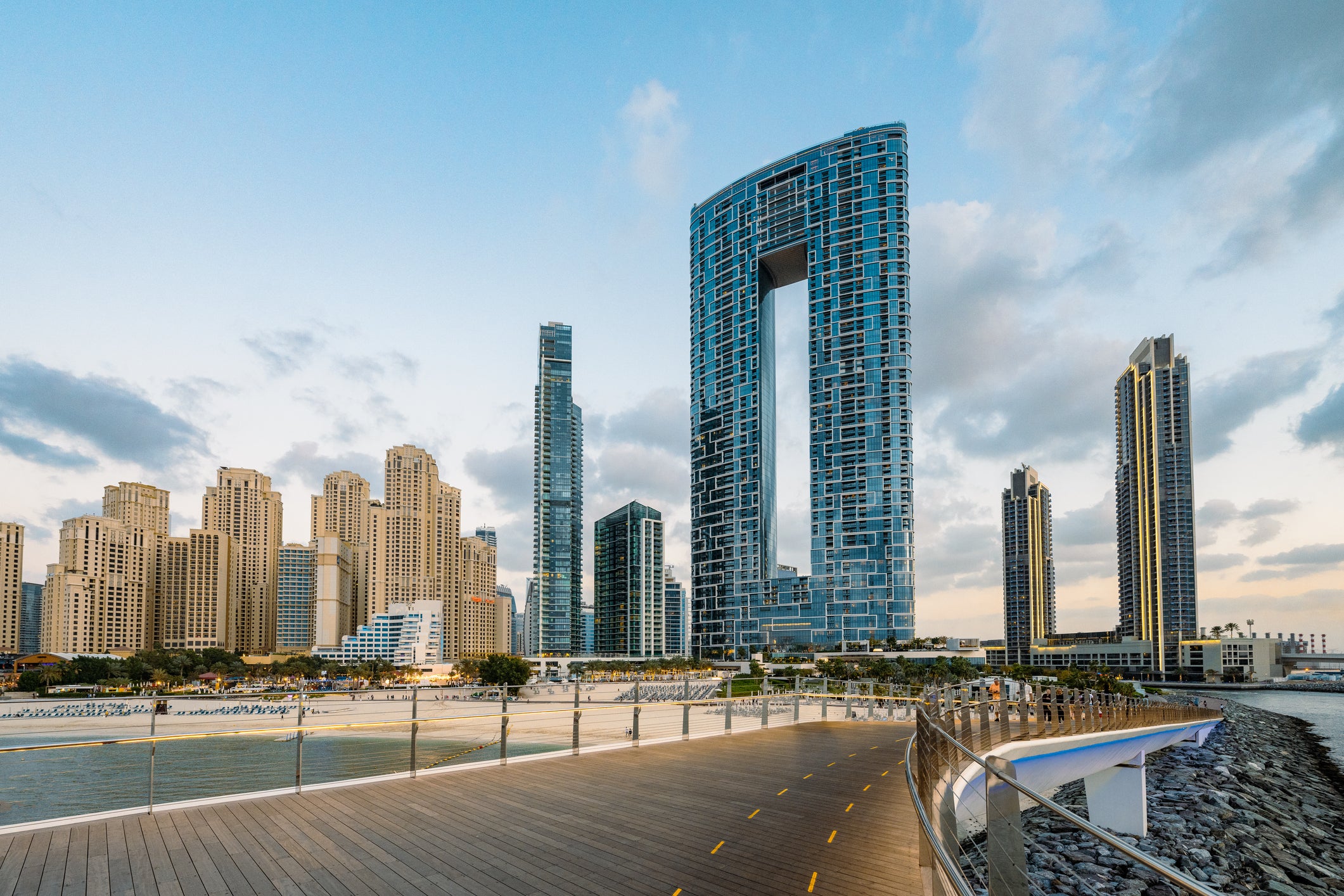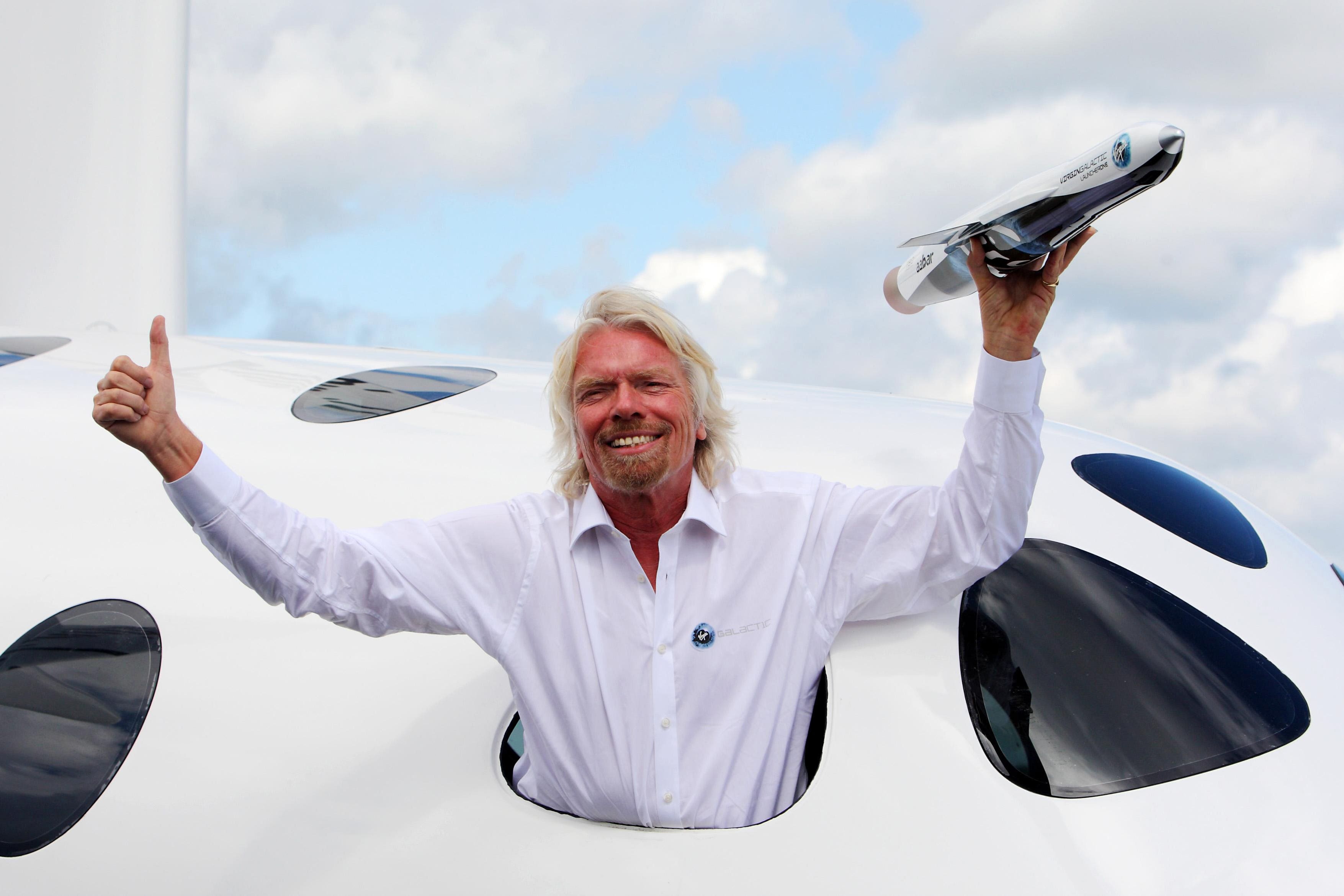SPACE / COSMOS
A 21st-century moon suit: Axiom Space's lunar spacesuit sports 4G comms, Prada looks and Oakley visors for Artemis astronauts
By Andrew Jones
Space.com
The AxEMU is designed to allow Artemis 3 astronauts to explore the south pole of the moon.

Oct 16/2024
The AxEMU is designed to allow Artemis 3 astronauts to explore the south pole of the moon.

Axiom Space and Prada unveiled the design of the new Axiom Extravehicular Mobility Unit (AxEMU) spacesuit at the International Astronautical Congress in Milan on Oct. 16, 2024. (Image credit: Andrew Jones/Space.com)
MILAN — If you're going to team up with Prada for a 21st-century moon suit, it only makes sense to unveil it in one of the fashion capitals of the world.
Axiom Space and Prada revealed the Axiom Extravehicular Mobility Unit (AxEMU) spacesuit in a press conference held at the International Astronautical Congress (IAC) here today (Oct. 16).
AxEMU will be used for NASA's Artemis 3 mission, which is currently scheduled to launch in late 2026. It has been specially designed for the lunar south pole, which will be a colder environment than astronauts experienced on the Apollo missions, which landed around the moon's equator.

The AxEMU spacesuit that Artemis astronauts will wear on the moon.
MILAN — If you're going to team up with Prada for a 21st-century moon suit, it only makes sense to unveil it in one of the fashion capitals of the world.
Axiom Space and Prada revealed the Axiom Extravehicular Mobility Unit (AxEMU) spacesuit in a press conference held at the International Astronautical Congress (IAC) here today (Oct. 16).
AxEMU will be used for NASA's Artemis 3 mission, which is currently scheduled to launch in late 2026. It has been specially designed for the lunar south pole, which will be a colder environment than astronauts experienced on the Apollo missions, which landed around the moon's equator.

The AxEMU spacesuit that Artemis astronauts will wear on the moon.
(Image credit: Axiom Space)
The new spacesuit incorporates multiple redundant systems and an onboard diagnostic system to ensure safety for crewmembers, according to Axiom. It features lights and an HD camera on the helmet, 4G/LTE communication, a suit control interface, biometric monitoring, regenerable carbon dioxide scrubbing and portable life support to keep astronauts safe for up to eight hours. It can also accommodate a wide range of crewmembers, male or female.
Related: Artemis moon suit designed by Axiom Space and Prada revealed in Milan (photos)
Matt Ondler, Axiom Space president, described the unveiling as an historic day. "So two years from now, when NASA applies the Artemis 3 mission, the astronauts will be wearing the suit design," Ondler said. "More profoundly for us, the first woman to walk on the moon will wear this suit, the first person of color [on the moon] will be wearing this suit, and the first non-American will be wearing this suit."
The suit needs to be ready for 2026, but further testing, including in vacuum chambers and reduced-gravity environments, is needed to meet the deadline. Teams have also been working on integration of the spacesuit with SpaceX's new Starship vehicle — which will be NASA's human landing system for the mission — and address any remaining interface challenges.
The partnership with Prada was highlighted as a cross-industry collaboration success. "I'm very proud of the result we're showing today, which is just the first step in a long-term collaboration with Axiom Space," said Lorenzo Bertelli, Prada chief marketing officer, in a statement. "We've shared our expertise on high-performance materials, features, and sewing techniques, and we learned a lot."
Get the Space.com Newsletter
Breaking space news, the latest updates on rocket launches, skywatching events and more!Contact me with news and offers from other Future brandsReceive email from us on behalf of our trusted partners or sponsorsBy submitting your information you agree to the Terms & Conditions and Privacy Policy and are aged 16 or over.
Russell Ralston, Axiom's executive vice president of extravehicular activity, speaking at the unveiling, said the partnership was groundbreaking.
"This collaboration exemplifies the power to create better technology solutions together by merging Axiom Space's elite engineering experience with Prada's all-round craftsmanship. We've blended engineering, science and art to produce the ultimate garments, ensuring that astronauts can perform their tasks and missions in safety and comfort."

The AxEMU suit has a variety of advanced features, including 4G/LTE communications and an HD camera system. (Image credit: Axiom Space)
Building a new suit for the extreme conditions on the moon has not exactly been a walk in the park, however.
Ralston, in response to a question, also highlighted many challenges, including the suit's boots. "How you insulate the foot from the surface is a tough challenge," Ralston said, noting the extreme temperatures and temperature changes, but also the need to ensure comfort and safety.
The suit has a mostly white external layer in order to reflect the sun and keep wearers cool despite extremely high temperatures. Many components also went through extensive testing to ensure the suit can withstand strong radiation environments.
AxEMU will not have a heads-up display but instead will come with a handheld device. This will offer an "enhanced confirmation display, imagery and navigation data," Ralston said.
The suit also has features and materials designed to combat the accumulation of fine and damaging lunar dust on the suit's exterior. This includes proprietary coatings and cleaning tools.
In contrast to Apollo suits, AxEMU is specifically geared to the lunar south pole. This means taking into account factors such as the sun often being low in the sky and affecting visibility. For this, Axiom looked elsewhere for solutions.
"We've partnered with others like Oakley for optimal system design to enhance astronaut visibility," Ondler said.
Related: The evolution of the spacesuit in pictures
AxEMU will not just be heading to the moon. The suit will also be used for Axiom's planned space station activities. "We also think there are commercial opportunities to work with commercial and private astronauts," Ondler said.
The architecture is evolvable, scalable and adaptable for missions on the lunar surface and in low Earth orbit, an Axiom statement noted.
Minor tweaks may still be made to AxEMU as the suit enters more strenuous testing. However, the team is committed to pushing forward with the schedule and ensuring the spacesuit is ready for its intended missions, according to Ondler.
It is not just Axiom's new lunar spacesuit that has recently emerged. China late last month unveiled the exterior design of its new extravehicular spacesuit that will allow its astronauts to walk on the moon. The country aims to launch its first crewed lunar mission before 2030.
Andrew Jones
Contributing Writer
Andrew is a freelance space journalist with a focus on reporting on China's rapidly growing space sector. He began writing for Space.com in 2019 and writes for SpaceNews, IEEE Spectrum, National Geographic, Sky & Telescope, New Scientist and others. Andrew first caught the space bug when, as a youngster, he saw Voyager images of other worlds in our solar system for the first time. Away from space, Andrew enjoys trail running in the forests of Finland. You can follow him on Twitter @AJ_FI.
The new spacesuit incorporates multiple redundant systems and an onboard diagnostic system to ensure safety for crewmembers, according to Axiom. It features lights and an HD camera on the helmet, 4G/LTE communication, a suit control interface, biometric monitoring, regenerable carbon dioxide scrubbing and portable life support to keep astronauts safe for up to eight hours. It can also accommodate a wide range of crewmembers, male or female.
Related: Artemis moon suit designed by Axiom Space and Prada revealed in Milan (photos)
Matt Ondler, Axiom Space president, described the unveiling as an historic day. "So two years from now, when NASA applies the Artemis 3 mission, the astronauts will be wearing the suit design," Ondler said. "More profoundly for us, the first woman to walk on the moon will wear this suit, the first person of color [on the moon] will be wearing this suit, and the first non-American will be wearing this suit."
The suit needs to be ready for 2026, but further testing, including in vacuum chambers and reduced-gravity environments, is needed to meet the deadline. Teams have also been working on integration of the spacesuit with SpaceX's new Starship vehicle — which will be NASA's human landing system for the mission — and address any remaining interface challenges.
The partnership with Prada was highlighted as a cross-industry collaboration success. "I'm very proud of the result we're showing today, which is just the first step in a long-term collaboration with Axiom Space," said Lorenzo Bertelli, Prada chief marketing officer, in a statement. "We've shared our expertise on high-performance materials, features, and sewing techniques, and we learned a lot."
Get the Space.com Newsletter
Breaking space news, the latest updates on rocket launches, skywatching events and more!Contact me with news and offers from other Future brandsReceive email from us on behalf of our trusted partners or sponsorsBy submitting your information you agree to the Terms & Conditions and Privacy Policy and are aged 16 or over.
Russell Ralston, Axiom's executive vice president of extravehicular activity, speaking at the unveiling, said the partnership was groundbreaking.
"This collaboration exemplifies the power to create better technology solutions together by merging Axiom Space's elite engineering experience with Prada's all-round craftsmanship. We've blended engineering, science and art to produce the ultimate garments, ensuring that astronauts can perform their tasks and missions in safety and comfort."

The AxEMU suit has a variety of advanced features, including 4G/LTE communications and an HD camera system. (Image credit: Axiom Space)
Building a new suit for the extreme conditions on the moon has not exactly been a walk in the park, however.
Ralston, in response to a question, also highlighted many challenges, including the suit's boots. "How you insulate the foot from the surface is a tough challenge," Ralston said, noting the extreme temperatures and temperature changes, but also the need to ensure comfort and safety.
The suit has a mostly white external layer in order to reflect the sun and keep wearers cool despite extremely high temperatures. Many components also went through extensive testing to ensure the suit can withstand strong radiation environments.
AxEMU will not have a heads-up display but instead will come with a handheld device. This will offer an "enhanced confirmation display, imagery and navigation data," Ralston said.
The suit also has features and materials designed to combat the accumulation of fine and damaging lunar dust on the suit's exterior. This includes proprietary coatings and cleaning tools.
In contrast to Apollo suits, AxEMU is specifically geared to the lunar south pole. This means taking into account factors such as the sun often being low in the sky and affecting visibility. For this, Axiom looked elsewhere for solutions.
"We've partnered with others like Oakley for optimal system design to enhance astronaut visibility," Ondler said.
Related: The evolution of the spacesuit in pictures
AxEMU will not just be heading to the moon. The suit will also be used for Axiom's planned space station activities. "We also think there are commercial opportunities to work with commercial and private astronauts," Ondler said.
The architecture is evolvable, scalable and adaptable for missions on the lunar surface and in low Earth orbit, an Axiom statement noted.
Minor tweaks may still be made to AxEMU as the suit enters more strenuous testing. However, the team is committed to pushing forward with the schedule and ensuring the spacesuit is ready for its intended missions, according to Ondler.
It is not just Axiom's new lunar spacesuit that has recently emerged. China late last month unveiled the exterior design of its new extravehicular spacesuit that will allow its astronauts to walk on the moon. The country aims to launch its first crewed lunar mission before 2030.
Andrew Jones
Contributing Writer
Andrew is a freelance space journalist with a focus on reporting on China's rapidly growing space sector. He began writing for Space.com in 2019 and writes for SpaceNews, IEEE Spectrum, National Geographic, Sky & Telescope, New Scientist and others. Andrew first caught the space bug when, as a youngster, he saw Voyager images of other worlds in our solar system for the first time. Away from space, Andrew enjoys trail running in the forests of Finland. You can follow him on Twitter @AJ_FI.
The cataclysmic origins of most of Earth’s meteorites have been found
Seventy percent of meteorites can be linked to a just a handful of asteroid belt collisions

A brilliant meteor blazes through the sky over radio dishes of the Atacama Large Millimeter/submillimeter Array in the Chilean Andes.
Christoph Malin, ESO
By Robin George Andrews
Most of Earth’s meteorites can be linked to just a few collisions within the asteroid belt between Mars and Jupiter, two new studies report, including a particularly cataclysmic impact event around 470 million years ago.
The upside to this discovery, published October 16 in Nature, is that it provides researchers with vital context: By knowing the return address of meteorites, scientists can more easily work out how and where the building blocks of planets came together to create the solar system we see today. The downside is that it may mean researchers have an extremely biased meteorite collection that can tell only a sliver of the story.
Meteorites record the tumultuous history of the solar system’s formative years, but the origins of these ancient space rocks are often unknown (SN: 4/18/18). “It’s absolutely like a pot of gold at the end of a rainbow for a meteoriticist to know what asteroid the sample’s come from,” says Sara Russell, a planetary scientist at London’s Natural History Museum who wasn’t involved with either study. Without that information, a meteorite is like a piece of a jigsaw puzzle without a picture of the full puzzle to accompany it.
Most of the meteorites on Earth are stony ones named ordinary chondrites. Two classes of these chondrites, known as H and L, make up 70 percent of all meteorite falls.
Scientists had suspected that the L chondrites originated from a single parent asteroid. Many have mineralogical features indicating they were heavily shocked, scorched and degassed before gradually cooling, implying they were liberated from a giant asteroid — at least 100 kilometers long — via a supersonic collision.
Using radioactively decaying elements to determine the age of the meteorites has revealed that they first emerged from a collision that happened 470 million years ago. To search for the site of that destruction derby in the asteroid belt, researchers used NASA’s Infrared Telescope Facility in Hawaii to scan many prominent stony-type asteroids, comparing each one’s mineral signatures to those of L chondrites.
The best fit was a group of asteroids named the Massalia family. Their scattered presence and current orbits could effectively be rewound by the scientists — and it looked like the asteroids all formed around 500 million years ago after splitting from an older, larger asteroid. That timing suggested that the impact that created the L chondrites also created the Massalia family. One of the asteroids in that family is about 140 kilometers long, a perfect fit for the estimated size range of the L chondrite parent body.
Other independent lines of data also point to the Massalia family, including the fact that near-Earth asteroids with L chondrite–like signatures have orbits that trace back to the family, as do the orbits of the L chondrite meteors that burn through Earth’s skies, before leaving telltale meteorites behind.
“All point at the same thing. There’s no doubt,” says Michaël Marsset, an astronomer at the European Southern Observatory in Santiago, Chile, and an author of both studies.
That ancient impact also set the stage for a more recent bombardment, sending streams of L chondrite material tumbling back onto the largest asteroid remnant. Another impact no more than 40 million years ago then sent that rubble Earth’s way.
What of the H chondrites? Many are 5 million to 8 million years old, so came from a different impact event — or two events, it seems. By reconstructing the past orbits of the mineralogically matching Koronis2 asteroid family, the team found that many of those asteroids existed unified as a single asteroid 7.6 million years ago.
Prior research had already applied the same time-rewinding technique to another asteroid group, known as the Karin family, and found many of those were also united as a solitary asteroid 5.8 million years ago, just before another asteroid struck it. As both families cover each end of the date range for the H chondrites, the team concluded that they are the source of this meteorite class.
That Earth’s meteorite collection could be highly biased to just a few asteroids is distressing, Russell says. The asteroid belt is home to a dizzying array of rocks, boulders and even dwarf planets, each revealing something unique about the solar system (SN: 8/3/16). “Maybe we’re only just seeing a tiny fraction of them” through our meteorites, she says.
There is a solution, though more costly than scouring Earth for more meteorites. “We’ve got to have space missions to go out there,” she says, and hunt these ancient rocky archives down ourselves (SN: 2/15/24).
Citations
M. Brož et al. Young asteroid families as the primary source of meteorites. Nature. Published online October 16, 2024. doi: 10.1038/s41586-024-08006-7.
M. Marsset et al. The Massalia asteroid family as the origin of ordinary L chondrites. Nature. Published online October 16, 2024. doi: 10.1038/s41586-024-08007-6.
About Robin George Andrews
Saturn’s first Trojan asteroid has finally been discovered
All four giant planets now have known asteroids sharing their orbits

Saturn is known for its stunning rings and its many moons (four seen here), but they aren’t the planet’s only companions. Its first known Trojan — an asteroid that shares the planet’s orbit around the sun — has now been discovered.
USGS/JPL/NASA
The final 3D atlas of the sky will help scientists study dark matter and dark energy, which make up 96 percent of the universe but remain mysterious
:focal(960x549:961x550)/https://tf-cmsv2-smithsonianmag-media.s3.amazonaws.com/filer_public/f4/7b/f47b89c4-4f38-4570-bc12-e5c5ecb54455/euclid_captures_core_of_abell_3381_galaxy_cluster_pillars.jpg)
An area of the mosaic released by ESA’s Euclid space telescope on October 15, 2024, which is zoomed in 36 times compared to the large mosaic.
ESA / Euclid / Euclid Consortium / NASA, CEA Paris-Saclay, image processing by J.-C. Cuillandre, E. Bertin, G. Anselmi
Margherita Bassi
Margherita Bassi
SMITHSONIAN
Daily Correspondent
Daily Correspondent
Smart News | October 16, 2024
On its mission to reveal the secrets of the “dark universe,” the Euclid space telescope has released its most detailed image yet. The wide-angle telescope built and operated by the European Space Agency (ESA) has been investigating the cosmos since it launched into space aboard a SpaceX Falcon 9 rocket on July 1, 2023.
Its mission? To create a 3D map of one-third of the sky—the largest such map ever made. This “cosmic atlas,” as it’s also called, will be the culmination of six years of observations with Euclid’s 600-megapixel camera, studying billions of galaxies up to ten billion light-years away.
The world got its first sneak peeks of Euclid’s magnificent images in November 2023 and May 2024, with the space telescope’s survey officially beginning in February of this year. These first looks only built up anticipation in the scientific community, which expressed thrill and awe when ESA officials revealed the first part of Euclid’s cosmic atlas at the International Astronautical Congress in Milan, Italy, on Tuesday./https://tf-cmsv2-smithsonianmag-media.s3.amazonaws.com/filer_public/bd/08/bd085f28-4822-4286-8688-ce10e76c2de2/mosaic_of_euclid_observations_in_the_southern_sky_pillars.jpg)
On its mission to reveal the secrets of the “dark universe,” the Euclid space telescope has released its most detailed image yet. The wide-angle telescope built and operated by the European Space Agency (ESA) has been investigating the cosmos since it launched into space aboard a SpaceX Falcon 9 rocket on July 1, 2023.
Its mission? To create a 3D map of one-third of the sky—the largest such map ever made. This “cosmic atlas,” as it’s also called, will be the culmination of six years of observations with Euclid’s 600-megapixel camera, studying billions of galaxies up to ten billion light-years away.
The world got its first sneak peeks of Euclid’s magnificent images in November 2023 and May 2024, with the space telescope’s survey officially beginning in February of this year. These first looks only built up anticipation in the scientific community, which expressed thrill and awe when ESA officials revealed the first part of Euclid’s cosmic atlas at the International Astronautical Congress in Milan, Italy, on Tuesday.
/https://tf-cmsv2-smithsonianmag-media.s3.amazonaws.com/filer_public/bd/08/bd085f28-4822-4286-8688-ce10e76c2de2/mosaic_of_euclid_observations_in_the_southern_sky_pillars.jpg)
This mosaic capturing a section of the southern sky contains 260 observations from the Euclid space telescope gathered over the course of just two weeks. ESA / Euclid / Euclid Consortium / NASA, CEA Paris-Saclay, image processing by J.-C. Cuillandre, E. Bertin, G. Anselmi
This first section is a mosaic created from 260 observations of the southern sky captured between March 25 and April 8, 2024, per a statement from the ESA. The final product is a 208-gigapixel image revealing tens of millions of stars in the Milky Way, as well as 14 million other galaxies in shocking detail. To the human eye, its area is equivalent to more than 500 times the area of the full moon as it appears in the sky.
“This stunning image is the first piece of a map that in six years will reveal more than one-third of the sky,” Valeria Pettorino, a Euclid project scientist at ESA, says in the statement. “This is just 1 percent of the map, and yet it is full of a variety of sources that will help scientists discover new ways to describe the universe.”
Euclid is nicknamed the “dark universe detective,” because it’s meant to reveal truths about little-understood phenomena such as dark energy and dark matter, which make up about 96 percent of the universe. Dark energy is hypothesized to be the cause behind the universe’s accelerated expansion. But details about these “dark” elements of the universe remain a mystery.
To shed light on these concepts, Euclid will image a wide range of galaxies. Dark matter will have bent the light from the most distant galaxies over time, so scientists could work backward from Euclid’s observations to find out where that dark matter lies. By tracing the distribution of galaxies throughout the universe’s history, the telescope can also uncover more about dark energy.
“Euclid is observing the universe in a brand new way, and it’s gonna get a gigantic census of the galaxies,” Universidad ECCI cosmologist Luz Ángela García Peñaloza tells Space.com’s Robert Lea. “Any image that reveals information about the distribution of galaxies in the large-scale structure of the universe will provide handfuls of information on the nature of the dark side of the cosmos.”
This first section is a mosaic created from 260 observations of the southern sky captured between March 25 and April 8, 2024, per a statement from the ESA. The final product is a 208-gigapixel image revealing tens of millions of stars in the Milky Way, as well as 14 million other galaxies in shocking detail. To the human eye, its area is equivalent to more than 500 times the area of the full moon as it appears in the sky.
“This stunning image is the first piece of a map that in six years will reveal more than one-third of the sky,” Valeria Pettorino, a Euclid project scientist at ESA, says in the statement. “This is just 1 percent of the map, and yet it is full of a variety of sources that will help scientists discover new ways to describe the universe.”
Euclid is nicknamed the “dark universe detective,” because it’s meant to reveal truths about little-understood phenomena such as dark energy and dark matter, which make up about 96 percent of the universe. Dark energy is hypothesized to be the cause behind the universe’s accelerated expansion. But details about these “dark” elements of the universe remain a mystery.
To shed light on these concepts, Euclid will image a wide range of galaxies. Dark matter will have bent the light from the most distant galaxies over time, so scientists could work backward from Euclid’s observations to find out where that dark matter lies. By tracing the distribution of galaxies throughout the universe’s history, the telescope can also uncover more about dark energy.
“Euclid is observing the universe in a brand new way, and it’s gonna get a gigantic census of the galaxies,” Universidad ECCI cosmologist Luz Ángela García Peñaloza tells Space.com’s Robert Lea. “Any image that reveals information about the distribution of galaxies in the large-scale structure of the universe will provide handfuls of information on the nature of the dark side of the cosmos.”
/https://tf-cmsv2-smithsonianmag-media.s3.amazonaws.com/filer_public/38/34/3834c949-7b93-43ab-b628-85abfe60ceb0/euclid_beholds_a_distant_swirling_spiral_galaxy_pillars.jpg)
Spiral galaxy ESO 364-G036 appears in detail, even though this view is zoomed in 600 times from Euclid's full mosaic. ESA / Euclid / Euclid Consortium / NASA, CEA Paris-Saclay, image processing by J.-C. Cuillandre, E. Bertin, G. Anselmi
Astronomers can zoom into the mosaic 600 times relative to the original image and still see celestial bodies in shocking detail. The telescope resolved the structure of spiral galaxy ESO 364-G036, which is about 420 million light-years away and fills up less than 0.0003 percent of the mapped area.
Another magnificent element captured by Euclid in this first atlas section is “galactic cirrus,” a mix of galactic gas and dust that forms dim clouds between the stars within our galaxy and reflects optical light from the Milky Way. Like wispy cirrus clouds on Earth, this phenomenon appears as streaks of light blue in the image.
“Before Euclid, we would never be able to see the faint cirrus clouds in the Milky Way and pick out every star that’s illuminating them in super-high resolution,” Mat Page, lead for Euclid’s VIS (visible instrument) camera, tells the Guardian’s Nicola Davis.
Astronomers can zoom into the mosaic 600 times relative to the original image and still see celestial bodies in shocking detail. The telescope resolved the structure of spiral galaxy ESO 364-G036, which is about 420 million light-years away and fills up less than 0.0003 percent of the mapped area.
Another magnificent element captured by Euclid in this first atlas section is “galactic cirrus,” a mix of galactic gas and dust that forms dim clouds between the stars within our galaxy and reflects optical light from the Milky Way. Like wispy cirrus clouds on Earth, this phenomenon appears as streaks of light blue in the image.
“Before Euclid, we would never be able to see the faint cirrus clouds in the Milky Way and pick out every star that’s illuminating them in super-high resolution,” Mat Page, lead for Euclid’s VIS (visible instrument) camera, tells the Guardian’s Nicola Davis.
/https://tf-cmsv2-smithsonianmag-media.s3.amazonaws.com/filer_public/6d/e2/6de2bee5-4780-4b9a-b76a-de1cc2cd023a/euclid_s_mosaic_on_gaia_and_planck_sky_map_pillars.jpg)
Shown against a backdrop of the entire universe, Euclid's new detailed mosaic (highlighted in yellow) makes up just 1 percent of what the telescope will capture. ESA / Euclid / Euclid Consortium / NASA; ESA / Gaia / DPAC; ESA / Planck Collaboration
Since February, Euclid has completed 12 percent of its survey. In March 2025, experts and casual enthusiasts alike can expect the reveal of 53 square degrees of the map, as well as a preview of the Euclid Deep Field areas—a detailed survey of just three patches of sky. Data from the mission’s first year will be released in 2026.
“This is just the beginning of what we will be able to see in Euclid’s lifetime,” García Peñaloza adds to Space.com. “For sure, the best is still to come! I’m positive Euclid will shed light on our understanding of the cosmic mysteries.”
Since February, Euclid has completed 12 percent of its survey. In March 2025, experts and casual enthusiasts alike can expect the reveal of 53 square degrees of the map, as well as a preview of the Euclid Deep Field areas—a detailed survey of just three patches of sky. Data from the mission’s first year will be released in 2026.
“This is just the beginning of what we will be able to see in Euclid’s lifetime,” García Peñaloza adds to Space.com. “For sure, the best is still to come! I’m positive Euclid will shed light on our understanding of the cosmic mysteries.”
/https://tf-cmsv2-smithsonianmag-media.s3.amazonaws.com/accounts/headshot/Margherita_Bassi.png)
Margherita Bassi | READ MORE
Margherita Bassi is a freelance journalist and trilingual storyteller. Her work has appeared in publications including BBC Travel, Discover magazine, Live Science, Atlas Obscura and Hidden Compass.


















